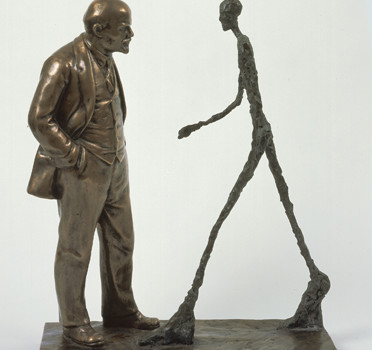Zimmerli Extends Exhibition Of Russian Artist Leonid Sokov


LENIN MEETS MODERNISM: The tension between the prescribed style of Socialist Realism and Western modernism is a recurring theme in the sculpture of Russian nonconformist artist Leonid Sokov. This 1990 bronze sculpture juxtaposing Lenin and Alberto Giacometti’s existential “Walking Man,” is part of an exhibition of the artist’s work at the Zimmerli Art Museum at Rutgers, now extended through December 31. For more information, call (848) 932.7237 or visit: www.zimmerlimuseum.rutgers.edu
The exhibition “Leonid Sokov: Ironic Objects” is being extended through December 31 at the Zimmerli Art Museum at Rutgers University in New Brunswick, which boasts “the world’s largest collection of art created during the Cold War era by Russian artists willing to risk life and limb to defy Soviet repression.”
Mr. Sokov is one of the most distinctive of such artists and the Zimmerli’s show is the first museum exhibition in the United States to be devoted to his career. The exhibition includes 80 of his works, many on view for the first time, ranging from sculptures created in the early 1960s to work created in 2000, more than a decade after the fall of the Berlin Wall.
Forty works drawn from the Zimmerli’s Norton and Nancy Dodge Collection of Soviet Nonconformist Art are accompanied by an equal number of loans from private collectors in the United States and the artist himself.
Unlike many of his fellow dissidents who overtly adopted the strategies of the American and European vanguard, in the 1970s and 1980s Mr. Sokov preferred to assume the stance of the “simple man” in his art making. In so doing, he won widespread acclaim for roughly hewn and seemingly improvised sculptures and kinetic toy-like figures inspired by Russian folk art.
Today Mr. Sokov, 72, lives and works in the New York area. He is widely credited as one of the originators of the Sots Art movement — a Soviet version of Pop Art that emerged in the early 1970s.
“Over the years, Leonid Sokov has employed the forms of naïve art to create a layered and sophisticated body of work,” said Suzanne Delehanty, director of the Zimmerli. “We are proud to present this overview of his career at the Zimmerli, the only museum in the country where it is possible to consider his achievement within the larger context of Soviet nonconformist art. The museum’s Dodge Wing, featuring works by Bulatov, Kabakov, Komar, Melamid, and other leading artists of the Cold War movement, are just steps away from ‘Leonid Sokov: Ironic Objects.’“
Julia Tulovsky, associate curator for Russian and Soviet nonconformist art at the Zimmerli, has organized “Leonid Sokov: Ironic Objects” at a time of increased interest in the artist’s work. In 2012, the Moscow Museum of Modern Art (MMOMA) presented a major retrospective, to which the Zimmerli was a significant lender, and published a comprehensive accompanying catalogue, to which Tulovsky contributed an essay on Sokov’s art in relation to popular culture.
“Lenin, Stalin, Mickey Mouse, and Marilyn Monroe — Sokov spared no iconic figure as he portrayed the absurdities of 20th-century history, politics, and culture,” says Tulovsky. “Sokov is notable for how he embraced the broadest of cultural contexts, both high and low, and Soviet and American.”
The tension between the prescribed style of Socialist Realism and Western modernism is a recurring theme in Mr. Sokov’s sculpture, one to which he has often returned. This tension is the subject of the exhibition’s centerpiece, the installation “Shadows of Twentieth-Century Sculptures,” which Sokov created for the Russian Pavilion at the 2001 Venice Biennale. Here 100 miniature replicas of iconic sculptures by such modern masters as Alexander Calder and Constantin Brancusi are placed on a well-lit stand in the center of a 625-square-foot space. As the stand rotates, the tiny sculptures project large moving shadows on the surrounding walls. This poetic tribute to the disproportionate power of art and ideas has never before been seen in the U.S., and only once in Europe after its debut in Venice.
Many of the other works featured in “Ironic Objects” illustrate the artist’s humor. These include “Project to Construct Glasses for Every Soviet Person” (1976), a play on the cliché, “the Soviet way of seeing.” Created at a time when the Soviet regime was touting progress, but most citizens were experiencing severe deprivations, Mr. Sokov’s rustic and crudely rendered glasses suggested the poor quality of Soviet industrial production that obscured the view into the “bright Soviet future.” His waggish and oversized eyeglasses would have evoked not just smiles, but outright laughter.
The Zimmerli Art Museum is located at 71 Hamilton Street at George Street on the College Avenue campus of Rutgers University in New Brunswick. The Zimmerli is a short walk from the NJ Transit train station in New Brunswick, midway between New York City and Philadelphia. For more information, call (848) 932-7237 or visit: www.zimmerlimuseum.rutgers.edu

